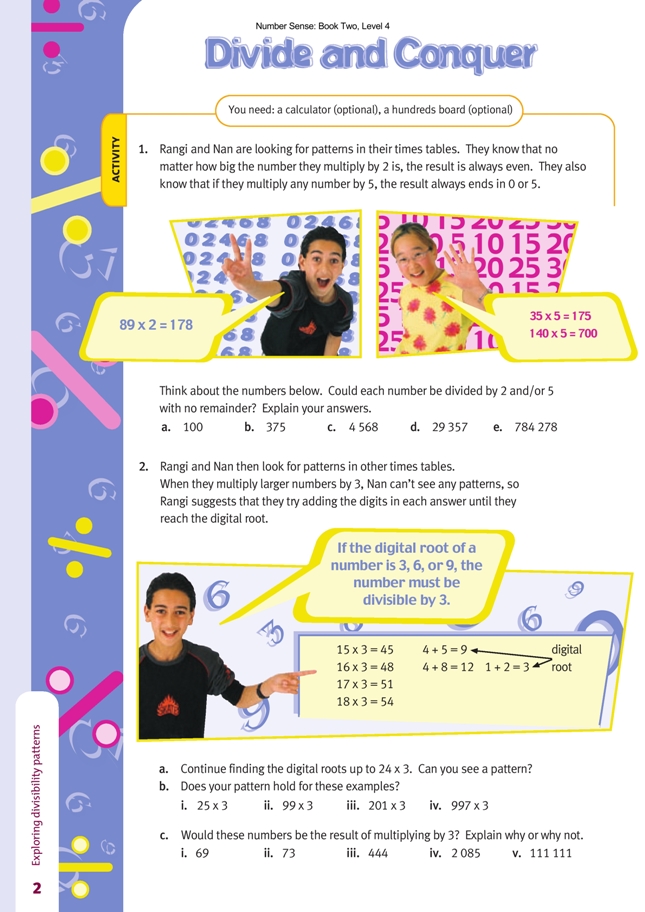This is a level 4 number activity from the Figure It Out series. It relates to Stage 7 of the Number Framework.
A PDF of the student activity is included.
Click on the image to enlarge it. Click again to close. Download PDF (651 KB)
use divisibility rules for 2, 3, and 5
FIO, Level 4, Number Sense, Book Two, Divide and Conquer, page 2
A hundreds board (optional)
For students who are still trying to establish a degree of number sense, a good way to start this activity might be to explore the hundreds board or chart. If they identified all the multiples of 2 (all the even numbers) and then all the multiples of 5, they would see that the numbers at the end of each row (that is, 10, 20, 30, and so on) are multiples of both 2 and 5. With this understanding, they could then try question 1.
A possible lead-in to question 2 would be to return to the hundreds chart and have the students identify all the multiples of 3. They may notice the diagonal pattern formed on the chart by these multiples. Another pattern that they can also be helped to recognise is that adding the digits in each diagonal pattern always results in the number at the top. For example, taking the first diagonal pattern, the numbers are 3, 12, and 21 (adding 1 and 2 results in 3; adding 2 + 1 also gives 3). Likewise, the second diagonal has the numbers 6, 15, 24, 33, 42, and 51 (all of which add up to 6). From this investigation, the students may be able to conclude that numbers that are multiples of 3 become 3, 6, or 9 when their digits are added. In the case of
larger numbers, such as 87, the digits may have to be added more than once to get to a single figure (8 + 7 = 15; 1 + 5 = 6).
Now the students are in a position to work on question 2. When they try question 2b, they need to do an example or two either side of the numbers given to check whether the pattern holds.
An interesting extension to question 1 that some students may wish to try has to do with multiplying by 5.
Since 5 is half of 10, they may wish to try multiplying larger numbers mentally by halving the number and then multiplying it by 10. Thus, 5 x 140 is 70 x 10. Odd numbers can be multiplied if decimals are used. For example, 5 x 35 is 17.5 x 10, and 5 x 89 is 44.5 x 10.
A further extension activity would be to consider the digital roots of multiples of 9. The students should soon discover that the digital root of such a product is always 9.
Answers to Activity
1. a. It can be divided by 2 and 5. Multiples of 2 are even numbers, and multiples of 5 end in 0 or 5. 100 is even and ends in 0.
b. It can be divided only by 5. It is odd and ends in 5.
c. It can be divided only by 2. It is even, and it doesn’t end in 5 or 0.
d. It can’t be divided by 2 or 5. It isn’t even and doesn’t end in 5 or 0.
e. It can be divided only by 2. It is an even number, and it doesn’t end in 5 or 0.
2. a. 17 x 3 = 51. 5 + 1 = 6
18 x 3 = 54. 5 + 4 = 9
19 x 3 = 57. 5 + 7 = 12. 1 + 2 = 3
20 x 3 = 60. 6 + 0 = 6
21 x 3 = 63. 6 + 3 = 9
22 x 3 = 66. 6 + 6 = 12. 1 + 2 = 3
23 x 3 = 69. 6 + 9 = 15. 1 + 5 = 6
24 x 3 = 72. 7 + 2 = 9
The pattern (from lowest digital root) is 3, 6, 9, 3, … The digital roots are multiples of 3.
b. Yes. Their digital roots are multiples of 3. If you work out the digital roots on either side of each of these, the 3, 6, 9 pattern does apply. For example, with 99 x 3:
97 x 3 = 291. 2 + 9 + 1 = 12. 1 + 2 = 3
98 x 3 = 294. 2 + 9 + 4 = 15. 1 + 5 = 6
99 x 3 = 297. 2 + 9 + 7 = 18. 1 + 8 = 9
100 x 3 = 300. 3 + 0 + 0 = 3
The results are:
i. 25 x 3 = 75. 7 + 5 = 12. 1 + 2 = 3
ii. 99 x 3 = 297. 2 + 9 + 7 = 18. 1 + 8 = 9
iii. 201 x 3 = 603. 6 + 0 + 3 = 9
iv. 997 x 3 = 2 991. 2 + 9 + 9 + 1 = 21. 2 + 1 = 3
c. i. Yes. 6 + 9 = 15. 1 + 5 = 6
6 is a multiple of 3.
ii. No. 7 + 3 = 10. 1 + 0 = 1
10 is not a multiple of 3.
iii. Yes. 4 + 4 + 4 = 12. 1 + 2 = 3
3 is a multiple of 3.
iv. Yes. 2 + 0 + 8 + 5 = 15. 1 + 5 = 6
6 is a multiple of 3.
v. Yes. 1 + 1 + 1 + 1 + 1 + 1 = 6
6 is a multiple of 3.
3
